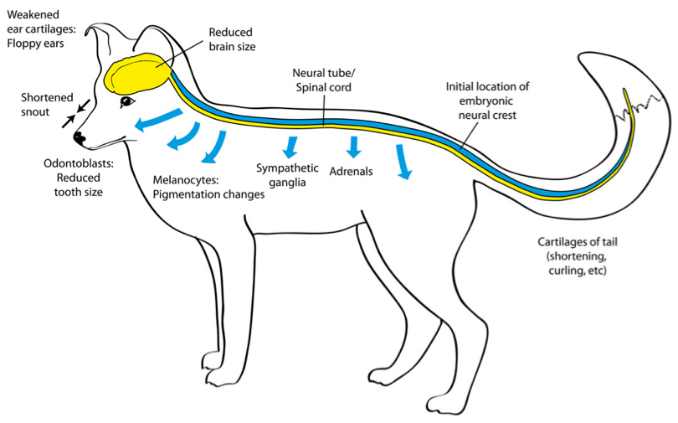In Stellenbosch, South Africa, in the shade of the university botanical gardens, Adam Wilkins and Richard Wrangham drank coffee and worked their way through a list.
Tameness. Smaller muzzles. Smaller teeth. Patches of white fur. Floppy ears.
In early 2011, Wilkins, Perspectives editor at GENETICS, and Wrangham, primatologist at Harvard, were both spending the semester at the picturesque Stellenbosch Institute for Advanced Study, on fellowships meant to provide “creative space for the mind.” The two scientists had run into each other at the photocopier when Wrangham noticed Wilkins was reading about a group of embryonic cells called the neural crest and its involvement in facial development.
Wrangham’s interest was piqued. He had heard an intriguing but unpublished idea about the neural crest from Tecumseh Fitch, University of Vienna cognitive biologist. Wilkins and Wrangham decided to chat.
Fitch’s idea? Altered neural crest development could be the reason mammals change in oddly consistent ways during domestication. As first noted by Darwin more than 140 years ago, domestic mammals tend to share certain characteristics—a suite of traits called the domestication syndrome.
The syndrome includes increased docility and tameness, coat color changes, reductions in tooth size, changes in craniofacial morphology, alterations in ear and tail form, more frequent and nonseasonal estrus cycles, alterations in hormone levels, changed concentrations of neurotransmitters, prolonged juvenile behavior, and reduced forebrain size.
Wilkins and Wrangham set about listing these mysterious marks of domestication and trying to match them to tissues affected by the neural crest. Within half an hour they decided that neural crest changes could plausibly account for most of the syndrome’s traits.
“It was tremendously exciting,” says Wilkins. “We realized at that meeting over coffee, ‘gosh, this might actually be true! ’”
In this month’s issue of the journal GENETICS, Wilkins, Wrangham, and Fitch describe their hypothesis in a Perspectives article, along with the supporting evidence, and testable predictions. Their proposal is one of very few that attempt to explain the syndrome as a whole, rather than merely focusing on individual traits.
The neural crest hypothesis builds partly on observations from the long-running fox domestication experiments started in 1959 in Novosibirsk, Siberia, by Dmitri Belyaev. After generations of selection purely for tameness, Novosibirsk foxes today show not only a friendly, people-loving disposition reminiscent of dogs, but also seemingly unrelated traits like curly tails, floppier ears and patches of white fur.
One of the many changes seen in the tame foxes was reduced size and function of their adrenal glands, which release stress hormones during the “fight-or-flight” response. This dampened adrenal function may lie at the heart of the behavioral changes observed in domestication syndrome. Wilkins et al. argue that one way to end up with smaller adrenal glands is via mild deficits of the neural crest.
The neural crest is a cell population that pinches off from the edge of the developing neural tube duing early embryogenesis. These cells migrate to many parts of the body and form the precursors of a plethora of tissue types, including pigment cells, parts of the skull, larynx, ears, teeth, sympathetic nervous system, and, of course, parts of the adrenal glands. So subtle changes in neural crest cell numbers, migration, or proliferation would lead to widespread phenotypic effects.

Developmental schematic. The blue tube indicates the approximate position of the neural crest in the early embryo, and the blue arrows indicate pathways of neural crest cell migration. From Wilkins et al.
Wilkins et al. argue that their ideas dovetail with certain effects of human neural crest cell disorders, like the patches of depigmented skin and hair seen in Waardenburg syndrome or the jaw, ear and teeth phenotypes of Treacher Collins syndrome.
And even though neural crest cells don’t directly develop into the central nervous system, they could still partly explain why many domestic mammals have smaller forebrains than their wild ancestors. Experiments in chick embryos suggest that signals from neural crest cells play a crucial role in forebrain development. At this stage, not every component of the domestication syndrome can be firmly tied into the hypothesis. For example, the curly tails of dogs, pigs, and domestic foxes don’t have an obvious connection to neural crest deficits. Nonetheless, the authors believe enough links exist to warrant experimental tests of their predictions.
One such prediction is that domestic mammals will show differences in neural crest development compared to their wild counterparts. Another is that such differences will be due to many alleles with relatively small effects on neural crest development, rather than a few influential variants. The authors also suggest that some of the loci associated with tameness, such as those rapidly being uncovered in genetic analyses of domestic foxes and rats, will be involved in neural crest biology.
Because none of the authors run labs of the type required to test the hypothesis, they hope other researchers will take on the challenge of testing these ideas experimentally.
Although the collaboration sparked over coffee in the gardens was a lot of fun, Wilkins says the ideas they developed are important. The domestication syndrome is one of the oldest problems in the history of genetics and is intimately tied to understanding our own species.
“Domestication was a crucial step in the development of human civilizations. Without these animals, it’s hard to imagine that human societies would have thrived in the way they have,” he says.
The “Domestication Syndrome” in Mammals: A Unified Explanation Based on Neural Crest Cell Behavior and Genetics
Adam S. Wilkins, Richard W. Wrangham, and W. Tecumseh Fitch.
Genetics July 2014 197:795-808 doi:10.1534/genetics.114.114.165423
http://www.genetics.org/content/197/3/795.full
Press release: Domestication syndrome: White patches, baby faces and tameness













